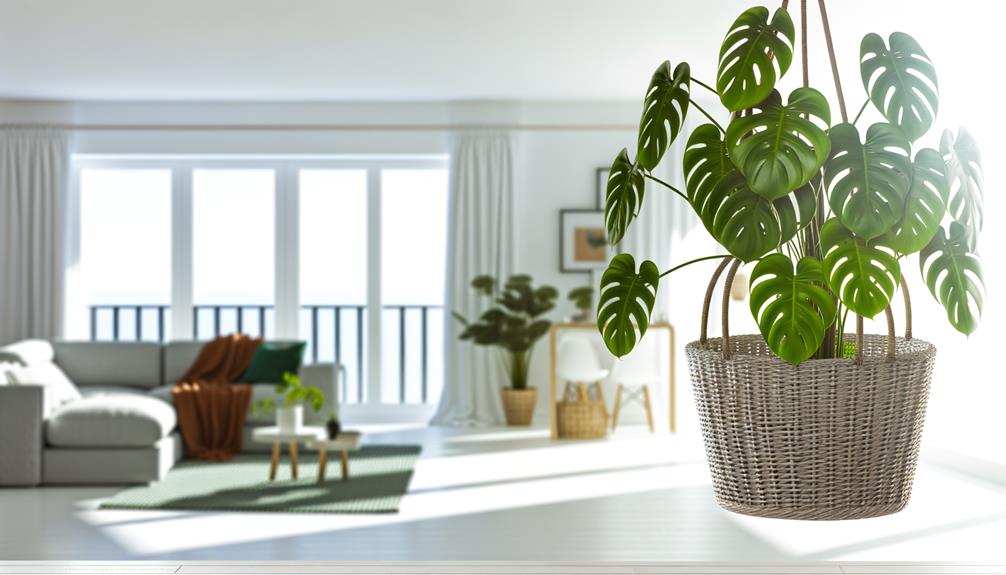Can You Hang a Monstera Deliciosa? Tips and Tricks!
Yes, you can hang a Monstera deliciosa, but it requires careful thought. Make sure the pot has outstanding drainage and aeration, and use a nutrient-rich, well-draining soil mix.
Place in bright, indirect light and maintain humidity above 60%. Regularly check soil moisture; water when the top inch is dry.
Support the plant with a moss pole or trellis to accommodate its climbing nature. Choose a strong planter to handle its weight and growth.
For best health and vigorous growth, follow these guidelines and explore further tips and techniques.

Key Takeaways
- Yes, a Monstera deliciosa can be hung if provided with adequate support and care.
- Ensure the hanging planter has proper drainage to avoid water accumulation and root rot.
- Use lightweight but sturdy materials like plastic or fiberglass for the hanging planter.
- Position the plant in bright, indirect light to mimic its natural habitat.
- Provide a moss pole or trellis in the hanging planter to support its climbing habit.
Understanding Monstera Deliciosa
When you’re trying to understand Monstera deliciosa, recognizing that this tropical plant thrives in environments that closely mimic its native rainforest habitat is essential. You’ll need to provide high humidity, indirect light, and well-draining soil.
Aim for a humidity level of at least 60%, using a humidifier if necessary. Place your Monstera in bright, indirect sunlight to avoid leaf burn. Make sure the soil mix is rich in organic matter and has good aeration consider using a combination of potting soil, perlite, and orchid bark.
Water the plant when the top inch of soil is dry, and make sure the pot has drainage holes. By replicating these conditions, you’ll support the healthy growth and characteristic fenestrations of your Monstera deliciosa.
Benefits of Hanging Plants
Hanging plants, including Monstera deliciosa, maximize space utilization while enhancing air circulation and light exposure, which can greatly improve the overall health and aesthetic appeal of your indoor garden.
By elevating your Monstera, you prevent soil compaction and root rot, as gravity aids in proper drainage. Improved light exposure guarantees photosynthesis occurs more efficiently, leading to vibrant foliage. Enhanced air circulation reduces the risk of fungal infections and pests, promoting a healthier microenvironment.
Additionally, hanging plants create a visually appealing vertical dimension, making your space feel larger and more dynamic. You’ll also find it easier to keep your Monstera out of reach from pets or children, safeguarding both your plant and your loved ones from potential harm.
Choosing the Right Planter
When selecting a planter for your Monstera Deliciosa, prioritize drainage and aeration to prevent root rot.
Guarantee the planter’s size and depth accommodate the plant’s growth and root spread.
Drainage and Aeration
Selecting a planter with excellent drainage and aeration properties is crucial to maintain a healthy Monstera Deliciosa. Opt for containers with multiple drainage holes to prevent root rot caused by waterlogging.
A well-draining soil mix, rich in organic matter, aids in moisture control and nutrient availability. Consider using a mix of peat, perlite, and orchid bark to enhance aeration and guarantee root oxygenation. Avoid overly compacted soils which can suffocate roots.
Elevate the planter slightly to allow airflow underneath, promoting further aeration. Incorporating activated charcoal at the base can also help reduce odors and improve drainage.
Size and Depth
Ensuring that your Monstera Deliciosa has a planter of adequate size and depth is essential for its root development and overall stability.
Select a planter that’s at least 1-2 inches larger in diameter than the current root ball. This allows the roots to expand and absorb nutrients efficiently.
Depth matters too; aim for a pot that’s at least 12 inches deep to accommodate the extensive root system. Avoid overly large planters as they can retain excess moisture, leading to root rot.
A well-sized planter provides equilibrium, ensuring your Monstera remains upright and healthy. Remember, proper root space fosters robust growth and minimizes the risk of toppling when hung.
Material and Weight
After determining the appropriate size and depth, focus on choosing a planter made of lightweight, durable materials like plastic or fiberglass to guarantee ease of hanging and longevity. These materials minimize strain on the hanging mechanism and reduce the risk of damage over time. Additionally, they help maintain the plant’s health by ensuring proper drainage and aeration.
Consider the following key aspects when selecting a planter:
| Material | Benefits |
|---|---|
| Plastic | Lightweight, inexpensive, durable |
| Fiberglass | Lightweight, UV-resistant, stylish |
| Ceramic | Aesthetic appeal, but heavier |
| Metal | Durable, but can be heavy and prone to rust |
Prioritize materials that offer the best balance between weight, durability, and functionality to support your Monstera Deliciosa effectively.
Selecting the Ideal Location
To guarantee your Monstera Deliciosa prospers, choose a location with bright, indirect sunlight and consistent temperatures between 65-75°F. Position your plant away from direct sunlight, which can scorch its leaves, and avoid placing it near drafts or heat sources that could cause temperature fluctuations.
An east or north-facing window is ideal, as it provides the right light intensity without excessive exposure. Maintain the humidity levels are at least 60% to mimic its natural tropical environment. You can increase humidity by using a humidifier or placing a water tray nearby.
Keep in mind that Monstera Deliciosa is sensitive to changes, so once you find an optimum spot, avoid relocating it frequently to prevent stress and encourage vigorous growth.
Required Support Systems
Once you’ve chosen the perfect location, it’s essential to provide your Monstera Deliciosa with a robust support system to encourage its natural climbing habit and promote healthy growth. Opt for a moss pole or a trellis, as these structures mimic the plant’s native environment. Secure the pole or trellis firmly in the pot, ensuring stability.
Gently tie the stems to the support using soft plant ties to avoid damaging the plant tissue. Regularly check and adjust these ties as the plant grows. Another option is using a wall-mounted support if space allows. This can provide vertical growth opportunities and improve air circulation.
Soil and Potting Mix
To guarantee your Monstera Deliciosa thrives, you’ll need to focus on the right soil composition and potting techniques. Opt for a well-draining mix that includes components like peat, perlite, and orchid bark, which replicate its natural habitat.
Regularly check the pot size and repot as needed to accommodate growth and prevent root-bound conditions.
Ideal Soil Composition
A well-draining potting mix rich in organic matter is essential for your Monstera deliciosa to thrive. You’ll want a mix that promotes aeration and moisture retention without becoming waterlogged.
Here are some key components to take into account:
- Peat moss: Retains moisture while providing some aeration.
- Perlite: Enhances drainage and prevents soil compaction.
- Bark chips: Improve aeration and mimic the plant’s natural environment.
- Compost: Adds nutrients and beneficial microorganisms.
Best Potting Practices
Building on the ideal soil composition, make sure you repot your Monstera deliciosa into a container with ample drainage holes to avoid waterlogging. Utilize a well-draining potting mix consisting of peat moss, perlite, and pine bark for optimal aeration and moisture retention. Avoid excessively compacted soils, as they impede root oxygenation, leading to root rot.
Here’s a quick reference table:
| Component | Purpose |
|---|---|
| Peat Moss | Retains moisture |
| Perlite | Enhances drainage |
| Pine Bark | Improves aeration |
| Drainage Holes | Prevents waterlogging |
| Pot Size | Accommodates root growth |
Repot every 1-2 years, increasing pot size gradually. Make sure the new soil mix remains consistent with these components to support healthy growth and prevent common Monstera issues.
Watering Guidelines
When watering your Monstera deliciosa, make certain the soil remains consistently moist but not waterlogged to prevent root rot. Use a well-draining potting mix to facilitate proper moisture levels.
During the growing season, water your plant when the top inch of soil feels dry. In the dormant season, reduce watering frequency, making sure that the soil is only slightly moist.
Remember these key points:
- Check soil moisture: Insert your finger into the soil to gauge dryness.
- Proper drainage: Guarantee your pot has drainage holes to avoid water accumulation.
- Humidity: Maintain high humidity levels around the plant, ideally 60-80%.
- Water quality: Use room-temperature, filtered water to avoid chlorine and fluoride buildup.
Following these guidelines will promote a healthy, thriving Monstera deliciosa.
Light Requirements
Monstera deliciosa thrives in bright, indirect light, making it essential to place your plant near a window with filtered sunlight. Direct sunlight can scorch its leaves, while low light will hinder growth. Utilize sheer curtains to diffuse sunlight or place the plant near an east-facing window.
| Light Condition | Effect on Monstera | Recommended Action |
|---|---|---|
| Direct Sunlight | Leaf burn | Use sheer curtains |
| Bright, Indirect | Excellent growth | Place near filtered sunlight |
| Low Light | Hindered growth | Relocate to brighter spot |
| Artificial Lighting | Adequate supplement | Use grow lights if necessary |
Ensure you rotate the plant periodically to maintain even growth and prevent leaning. By providing the right light conditions, you’ll help your Monstera deliciosa flourish.
Pruning and Maintenance
Proper light conditions set the stage for the next critical aspect of care: pruning and maintenance. Regular trimming guarantees your Monstera Deliciosa remains healthy and aesthetically pleasing. Use sterilized pruning shears to avoid disease transmission. Cut just above a node to encourage new growth. Remove any yellow or damaged leaves promptly.
To keep your Monstera thriving, follow these upkeep tips:
- Inspect regularly: Check for pests and diseases.
- Clean leaves: Wipe with a damp cloth to eliminate dust and enhance photosynthesis.
- Support stems: Use stakes or moss poles for structural reinforcement.
- Trim aerial roots: Prune them back if they become unruly.
Common Issues and Solutions
You’re likely to encounter yellowing leaves and drooping stems with your hanging Monstera Deliciosa. Address yellowing by checking for overwatering or nutrient deficiencies, and correct these issues promptly.
For drooping stems, provide adequate support and adjust watering practices to prevent further stress.
Yellowing Leaves Troubles
Yellowing leaves often indicate underlying issues that require immediate attention to maintain the health of your Monstera Deliciosa. You’ll need to identify the cause accurately to apply the appropriate solution.
Here are common culprits:
- Overwatering: Excess moisture leads to root rot. Guarantee your potting mix has excellent drainage and reduce watering frequency.
- Underwatering: Dehydration stresses the plant. Water thoroughly when the top inch of soil feels dry.
- Nutrient Deficiency: Lack of essential nutrients like nitrogen can cause chlorosis. Use a balanced, water-soluble fertilizer.
- Improper Lighting: Insufficient light can weaken your plant. Place your Monstera in bright, indirect sunlight for best growth.
Drooping Stems Fixes
Just like yellowing leaves, drooping stems can signal distress in your Monstera Deliciosa, often pointing to issues such as improper watering, insufficient support, or inadequate lighting conditions.
First, make sure you’re watering correctly Monstera prefers slightly moist soil but not waterlogged. Overwatering can lead to root rot, causing stems to droop.
Second, provide structural support with a moss pole or trellis, helping the plant maintain an upright posture.
Finally, check lighting conditions; Monstera thrives in bright, indirect light. Insufficient light can weaken stems, making them droop. Adjust placement to make sure it receives adequate illumination.
If you address these factors, you’ll likely see a significant improvement in your plant’s health and vigor.
Enhancing Aesthetic Appeal
Incorporating a Monstera Deliciosa into your space can greatly enhance its aesthetic appeal through its unique leaf patterns and vibrant green hue. This plant isn’t just a visual delight; it also offers practical benefits. By hanging your Monstera, you can create a dynamic focal point that draws the eye upward, making the room feel more spacious.
Here are some tips to maximize its aesthetic impact:
- Choose the right spot: Ensure it receives indirect sunlight to maintain leaf health.
- Use a sturdy hanger: The plant can get heavy as it grows.
- Prune regularly: Keep its shape manageable and visually appealing.
- Combine with other plants: Create a lush, layered look.
Conclusion
Hanging a Monstera deliciosa can transform your space into an extraordinary jungle paradise. With the right planter, ideal light, and solid support, your Monstera will thrive beyond your wildest dreams.
Regular pruning and attentive care guarantee it remains a stunning focal point. Address common issues promptly and you’ll enjoy the plant’s aesthetic and air-purifying benefits for years.
So, don’t hesitate—elevate your indoor greenery game and watch your Monstera reach new heights!






